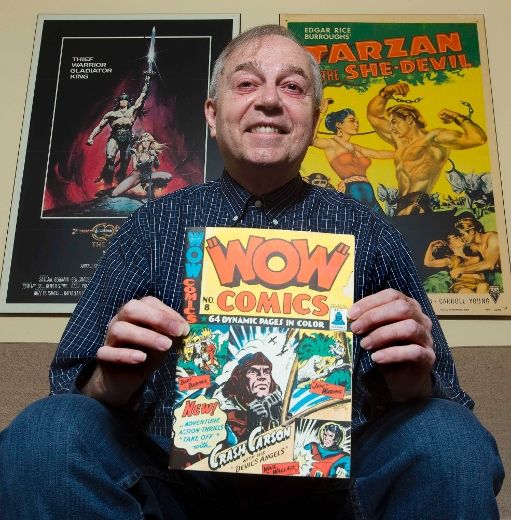
About a month ago, Eddy Smet, a retired math professor from Huron College at the University of Western Ontario (1976-2006), long time comic book collector and former comic book store owner (The Comic Book Collector—there was also an Eddy Smet Award given out at this year’s Shuster Awards for contributions to comic book culture in the London area, won by Diana Tamblyn) in London, Ontario, donated his collection of WECA comics to the Library at his former university. Now Eddy had already donated an accumulation of about 10,000 comic books (from over fourty years of collecting) to that same library back in December of 2009.
This time, however, the divesting involved a bigger part of his heart and soul as a comic book collector and Eddy was kind enough to let me mine his collection of about 125 Canadian Whites by taking photos and sharing in his deep knowledge of them over the last couple of years or so. The collection includes a nice example of one of the half-dozen existing copies of Canada’s first comic book, Better Comics No. 1, a great condition example of Triumph-Adventure Comics No. 2 which features the first Nelvana cover, as well as all four of the March 1941 Fox reprints by Canadian comic book publishers Anglo-American.
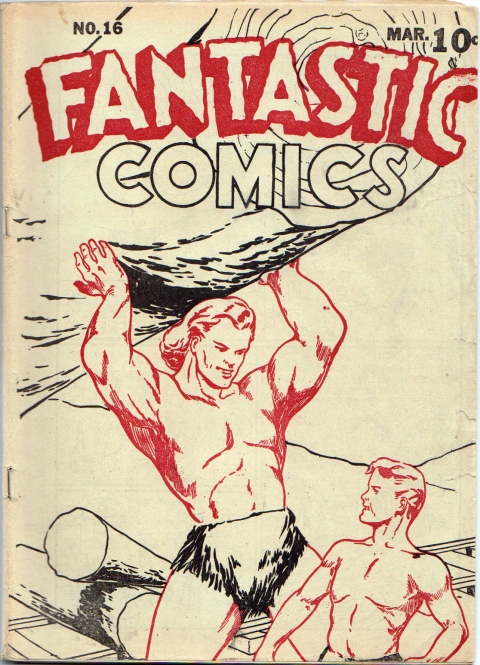
The collection also holds a copy of the Montreal Educational Projects one-shot, Famous Adventure Stories, a copy of the first issue of Maple Leaf’s Lucky Comics, a copy of that very difficult to find Your New Word Comic from out on the west coast, and a run of the first eight issues of Bell Features’ Wow Comics. Eddy also included a comprehensive and detailed binder of notes he has made on the contents of these Canadian war-time comics. This will be a stable and enduring treasure trove of information for future research in the area.
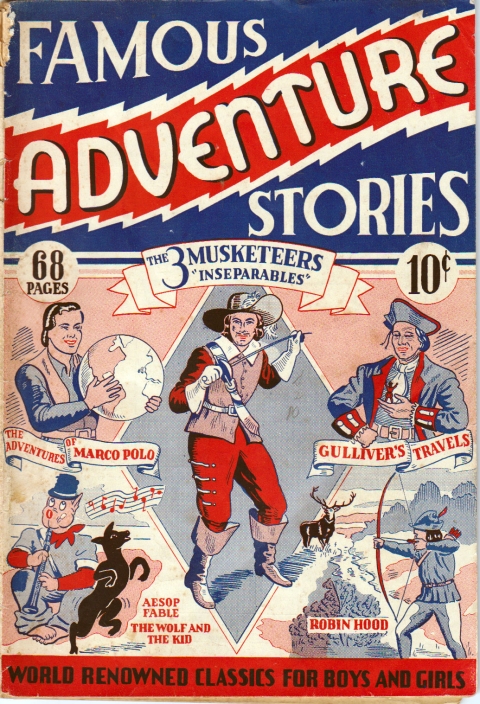
Here is an interview I did this spring with Eddy and his wife Zorka about their time operating a comic book store in London, Ontario.
Ivan Kocmarek: Do you recall when you first became interested in comics?
Eddy Smet: I was born in Belgium and my family came to Canada in 1950 when I was 7 so it was probably somewhere in the late fifties that I started with comics. Somewhere in these first years in Canada I acquired a collection of about 400 comics. I know I didn’t buy them of the stands, my family didn’t have the money for this, but I must have traded for them or got them from a friend. They were Dells, Classics, some Canadian reprint books and I do remember that I really treasured that collection and read something from it every day.
When I went to university (I got all my degrees from Western, 1962-73) I left that all behind and the collection stayed at my parents’ house. In the mid-sixties my mother asked if she could give the collection to one of my relatives but I only gave half of it and kept the other half. I ended up keeping the Dell and Atlas westerns, the Four Colors, the Tarzans, the Classics Illustrated, and the movie adaptation comics. It’s funny but these are the comics that will be the last ones I donate to Western because they are the closest to me.
IK: When did you start collecting again?
ES: Well I met my wife Zorka at university in the mid-sixties and we got married in 1968 when we were both in graduate school but I don’t think I began collecting again until about 1972 because I don’t remember buying a 15 cent comic off the newsstand. After this, I was buying almost every comic that came out and London wasn’t a good place for comic distribution. I remember going as far as Hamilton to pick up certain issues and also to Harry Kremer’s in Kitchener for back issues (…the first set I wanted to fill was the Tarzan run). What had changed for me was that I wasn’t reading my comics any more. I was buying almost every issue that came out but the magic of reading them wasn’t there like there was when I was a kid.
IK: So you began teaching at Huron College in 1976 and then you opened up The Comic Collector shop on Dundas in London three years later in 1979. How did that decision come about?
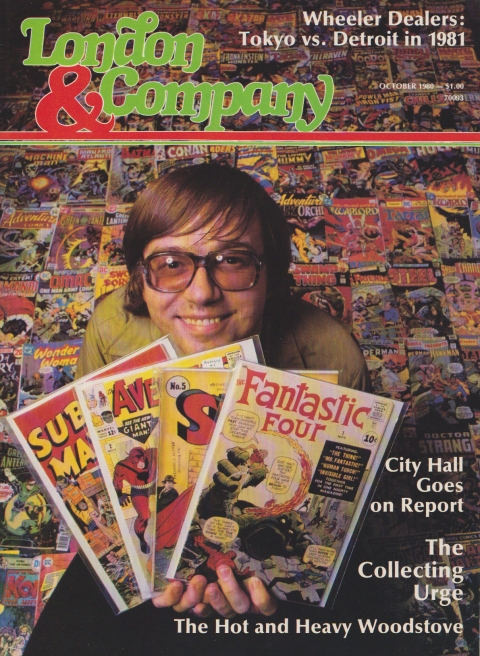
ES: Well, our apartment had a closet with shelves full of comics and I saw what Harry Kremer was doing in Kitchener and what was happening at the Silver Snail in Toronto. I’d also go to Captain George’s Memory Lane shop in Markham Village occasionally. At this point I had too many comics and had to get rid of some and even started selling them through classified ads right from the apartment. So you see there were a few thing happening. It was hard to find new comics in London, I wanted to sell off some of the comics I had, and I loved the idea of having a comic shop. All of that sort of came together. Zorka and I found an empty store within walking distance of our downtown apartment and we decided to open a comic book shop. Now I’m sure I would have talked to Harry [Kremer] about that because I wouldn’t have had a clue about how to get in touch with distributors. I don’t remember exactly how Harry helped but he would have given us all the detailed information we needed and he certainly would have offered us encouragement. The landlord of the property, Clyde McDow, rented the space (it was at 616 Dundas St. and adjoined his jewellery store) to us really cheap so that we could start on a shoestring. Everything was totally makeshift. We had used furniture from an old photographic studio. We made the contact with Multi-Books periodicals which distributed material to this part of Canada and we opened up The Comic Book Collector store on Saturday, September 29, 1976.
Zorka Smet: But we only did it part time…
IK: There’s something I wanted to ask you…. You were full time faculty at Western. How did you find time to start up a business in comics as well?
ES: Well, Zorka did most of the work….
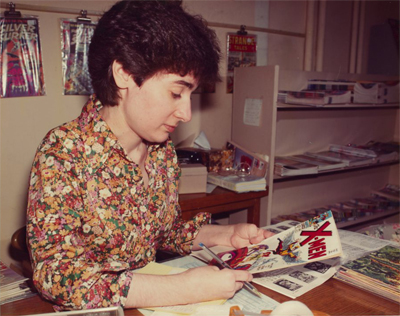
ZS: My mother helped a well and she loved to get out of the house.
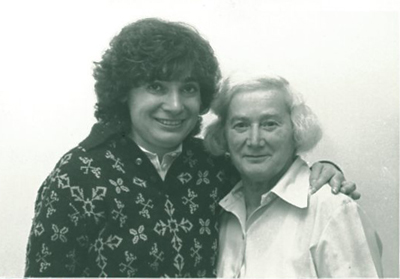
ES: I would have helped in the store in the evening but, fundamentally, the manager of the store was Zorka with her mother’s help. I would have been the main person making “buys,” but she did a lot of the grading and pricing and was the manager.
ZS: We did eventually hire a fellow, Mark Hunt, a nice young man who helped part time.
ES: Our store was only open three days a week, Thursday, Friday, and Saturday. We operated from 1979-1986, about seven years. I always had the university salary and the store was really just some extra income and fun but it was a viable business and a lot more viable than a current comic book store would be. We put in next to nothing and that store paid its costs almost from day one. There was no other comic book store in the city. Half of the sales were from back issues and it was on back issues that we would make a lot of money, often by accident. I mean that often someone would come in with a box of comics and say “What’ll you give me for them, I’m not waiting around?” I’d just see how many books there were and offer a dime for each book. The seller would be happy because he didn’t want to take the time to have me look through every book and there would often be a couple of gems in there that made some money for us. By the end of the business the sales would have been about $120,000 to $130,000 a year in 1980s dollars and we were clearing $25,000 to $30,000 of that which was great for a small, part time business.
ZS: We also had lists of comics that we would look for or set aside for our regular customers.
ES: When the shipment of new comics came in each week, I would sort through them and pick out the best copies for my regular customers but also I would set aside the very best copy for my own collection.
IK: What about your clientele? Was it mainly younger people, or a mixture…?
ES: It was quite a range of young and old people but very few women, though. Most of the customers would have been teenagers and the real collectors were young adults in their twenties but there were quite a few older customers, many older than me at the time.
IK: I remember you telling me that in the seven years the store operated, you never saw a Canadian White come through the store…
ES: No, I never did, but we did get some nice books such as a copy of Fantastic Four No. 1 and Superman 5 and a few golden age Sub-Mariners.
IK: What made you finally get out of the business in 1987?
ES: Well, Zorka began to develop a sort of allergic reaction to working with the comics and her mother had had a partial stroke and could no longer help in the store. Zorka’s reaction to working with the comics began to get worse and worse during that last year that we operated the store and eventually we decided to sell it and we sold it quietly to one of our best customers, Steve Jewett. He was recently out of the military and was looking for something to do. We sold it to him on lock, stock, and barrel for around $11-12,000… which was nothing really.

He took over on Oct. 1, 1987 and ran it for a number of years and then sold it to Tim Morris. Part of the agreement was that Zorka would train Steve in the operations of the store for a month or two after he took over and she did that working in the same surroundings and environment as she had before without any of the previous symptoms. The day after we sold the store Zorka’s “allergies” started to improve.
ZS: It probably was the stress of running the store more than allergies.
IK: Comic book stores are so different today and even collecting has changed so much since the time you operated the store. Today it’s all slabbing and decimal point grading increments, the internet and huge corporate cons full of cosplay. Can I ask you if there is anything that stands out in your memory from the time you ran the store?
ES: One thing I remember is when the Dark Knight Batman four issue mini-series first came out. It also came out in limited edition hard cover and we had a couple of customers who wanted that specific edition so we ordered 4 copies of it. It retailed at $75 but the hype was great and there was a feeding frenzy among collectors for the book even before it was released. They were willing to pay $400 or even $500 for a copy. Here’s the situation. The book wasn’t out yet and we were going to get these copies that we could easily sell at many multiples of our original cost. Well, we were only apportioned one copy from the distributer even though we had three orders for it. We picked the name at random from the three people who had ordered it and we sold it to them for the $75. This exemplifies how we ran the comic book store. We weren’t mercenary and were not in it to make the biggest profit that we could at any cost.
IK: Thanks Eddy and Zorka for sharing your memories of the time you operated The Comic Book Collector in London.
The second thing I’d like to share in this column is the fact that Bud Plant brought a Captain Marvel fan club letter from August, 1945 to my attention.
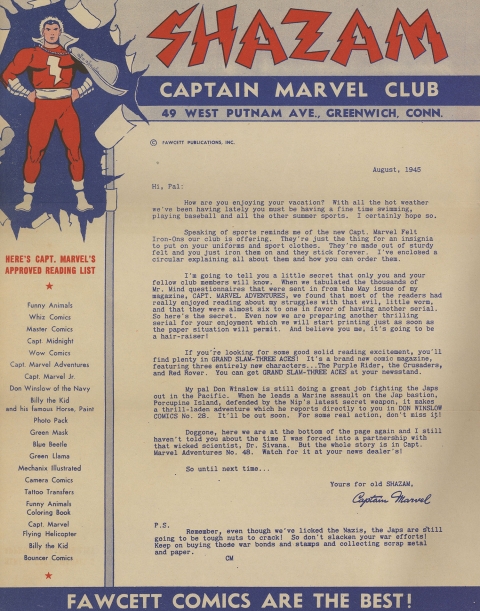
The significance of this letter is that, in it, Fawcett is announcing to readers that a new title, Grand-Slam, Three Aces Comics, is now available on the newsstands. This, of course, refers to one of our own WECA era comics—a title that Anglo American Publishers in Toronto had just converted to full colour. We know well the business relationship that had existed between Anglo-American and Fawcett since the start of 1942 in the sense that Anglo-American worked out a deal with Fawcett to purchase their scripts and redraw the stories for their audience in Canada. This letter seems to indicate that just as the American war in the Pacific was winding down, Fawcett had decided to distribute some of the Anglo-American titles in the states.
This letter seems to explain a newspaper photo I found online a couple of years ago of a boy reading a stack of comics in a second hand book and magazine store in the states.
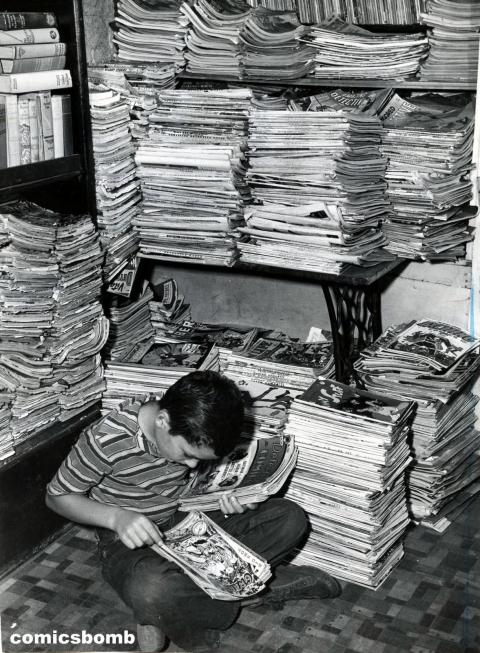
If you look closely at the comic he is looking at on the top of the pile in his lap, it is clearly Grand-Slam Three Aces from July, 1945, the first of the Anglo-American whites to be printed in full colour. Either somebody brought this comic book down from Canada when the crossed the border or, in light of the Fawcett letter, this book was distributed on the stands with American comics.
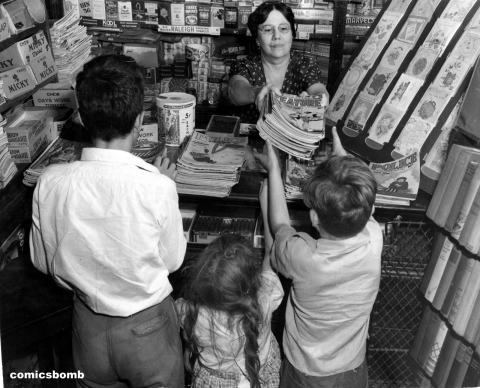
The photo is taken at a store in Wellston which is probably the Ohio Wellston. Let me know what you think about the letter and the photo.

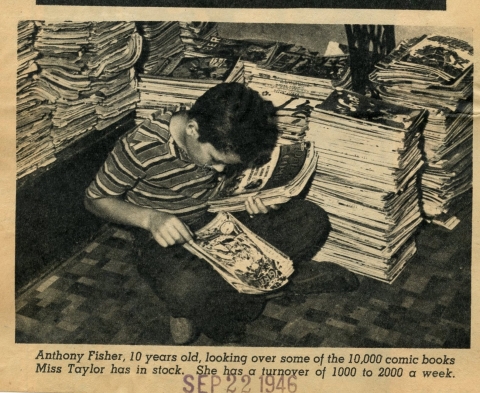
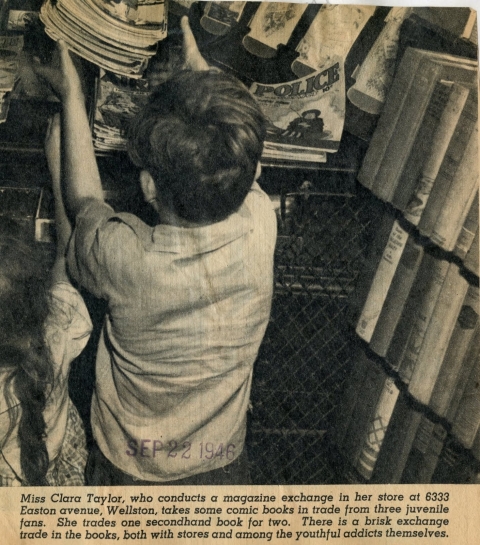



Ivan
another great post , loved the back story and especially the photos from the store . a real time capsule . also , I love it when old photos from back in the day newsstand are shown . kids didn’t realize how lucky they had it back then . you are right , every collector dreams about finding a motherload of comics in an old used book store !
Steve J.! Thanks for including that particular picture in this post. Where is my old buddy Steve these days? It would be nice to see him interviewed about his time at Comic Book Collector -aka CBC – also.
About those Grand Slam-3 Aces printings Ivan. Yes Double-A Comics did have two editions printed later on when they went to colour, in both Canada (at 172 John St.) and U.S.A (5309 Hamilton Avenue, Cleveland Ohio). If you search real hard you can find indicias of both, don’t ask me which edition is most common though, I haven’t ever seen circulation figures.
Yeah Chris, how many times have we all had that dream. With me lately, it’s been coming across a cache of WECA comics but the trouble is I know that it’s a dream–but that doesn’t disappoint me–I still revel in it.
Jim, wouldn’t it be great to do a post on what all those former comic book store owners from way back who are out of comics are doing now. It’d take a bit of work but what a great human interest piece that would be. And I should have posted the Ohio indicia from some of those later Anglos. I was surprised to find them a couple of years ago. It does mean that at least Fawcett thought they were good enough for the American public. It sort of redeems the quality of those war-time Canadian books in our own eyes.
Very intriguing Ivan. Hmm, be careful what you wish for, that idea for ‘where are they now’ sounds like it could quickly turn into a whole series of posts not just one.
Are you ready for the ‘bit of work’? And would you limit it to just Ontario, or go right across Canada looking at the older shops? I know there’s already a two part story online for Manitoba’s Doug Sulipa.
Thanks for your sober second thought, Jim. My “bit of work” phrase was a sarcastic understatement but I’d love to see this done by someone who had the energy and time. A start could be limiting it to the Toronto/Hamilton area. A good update of Ontario comic shops and their strengths would also certainly be welcome.
Wonder ul world of old-time collector-dealers. Can’t get enough of this sort of thing. Real Wimbledon Green stuff. Also the news that Fawcett dstro’d GS4A. Also the photos. Love.
Troublemaker! we said no.
Look Ivan, a volunteer to help with the old comic store posts!
Now if only we had a message forum to spread the work around, as in ‘many hands make light work’!
Better yet a working message forum on a website about Canadian Golden Age Comics where old guys can buy, sell and TALK about those comic stores they used to buy and sell from when they were still open.
If you can make that happen Ivan I think the story could write itself with you as the editor and Shepard-in-Chief with the ability you have of gathering the flock when it comes to these subjects dear to our hearts.